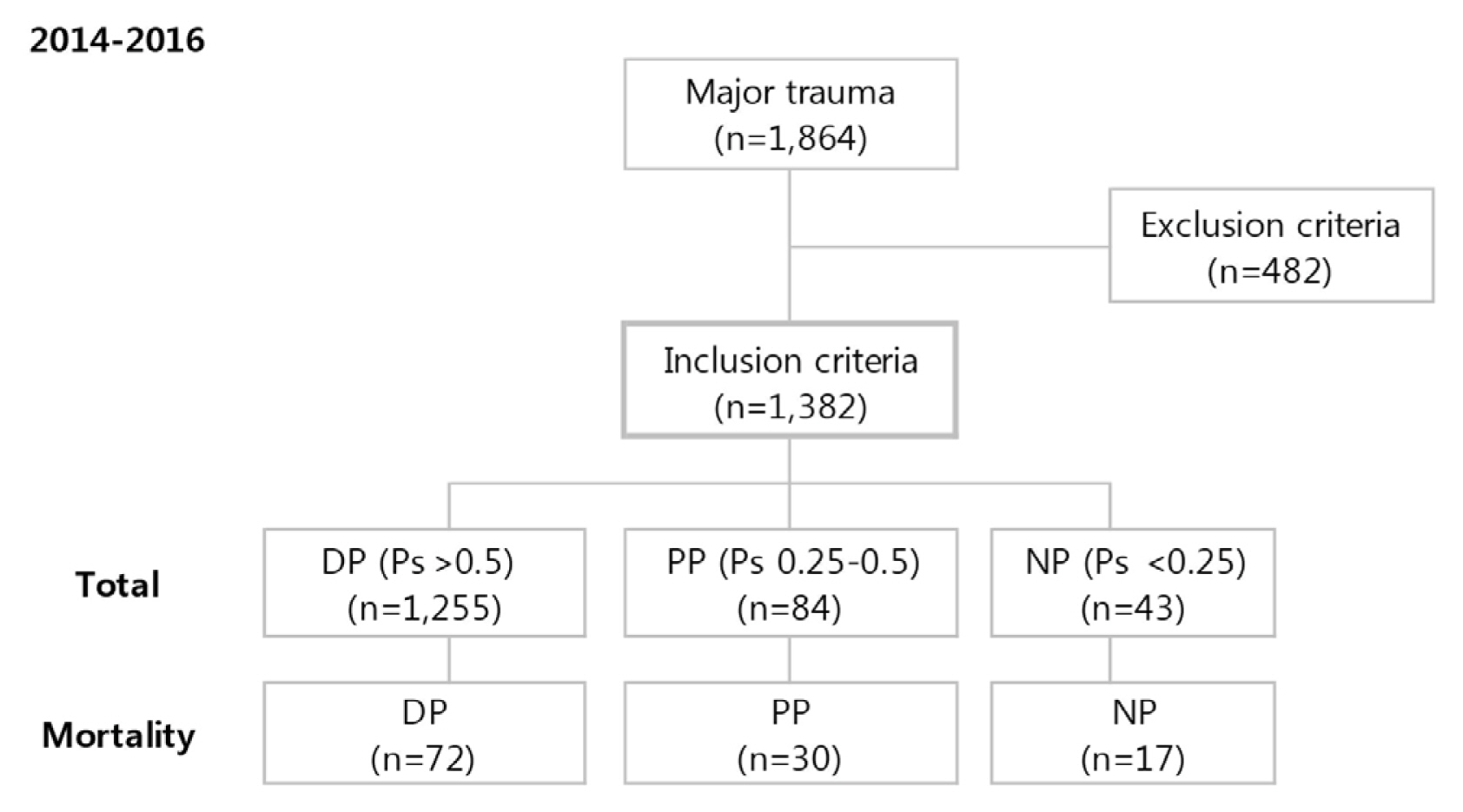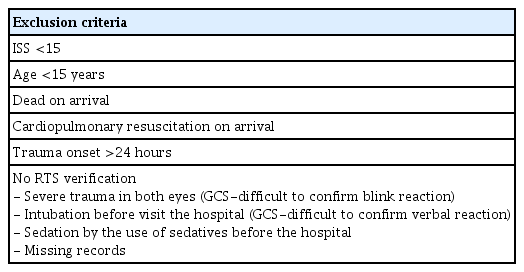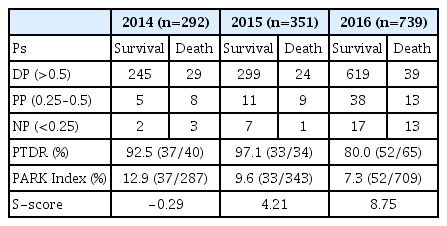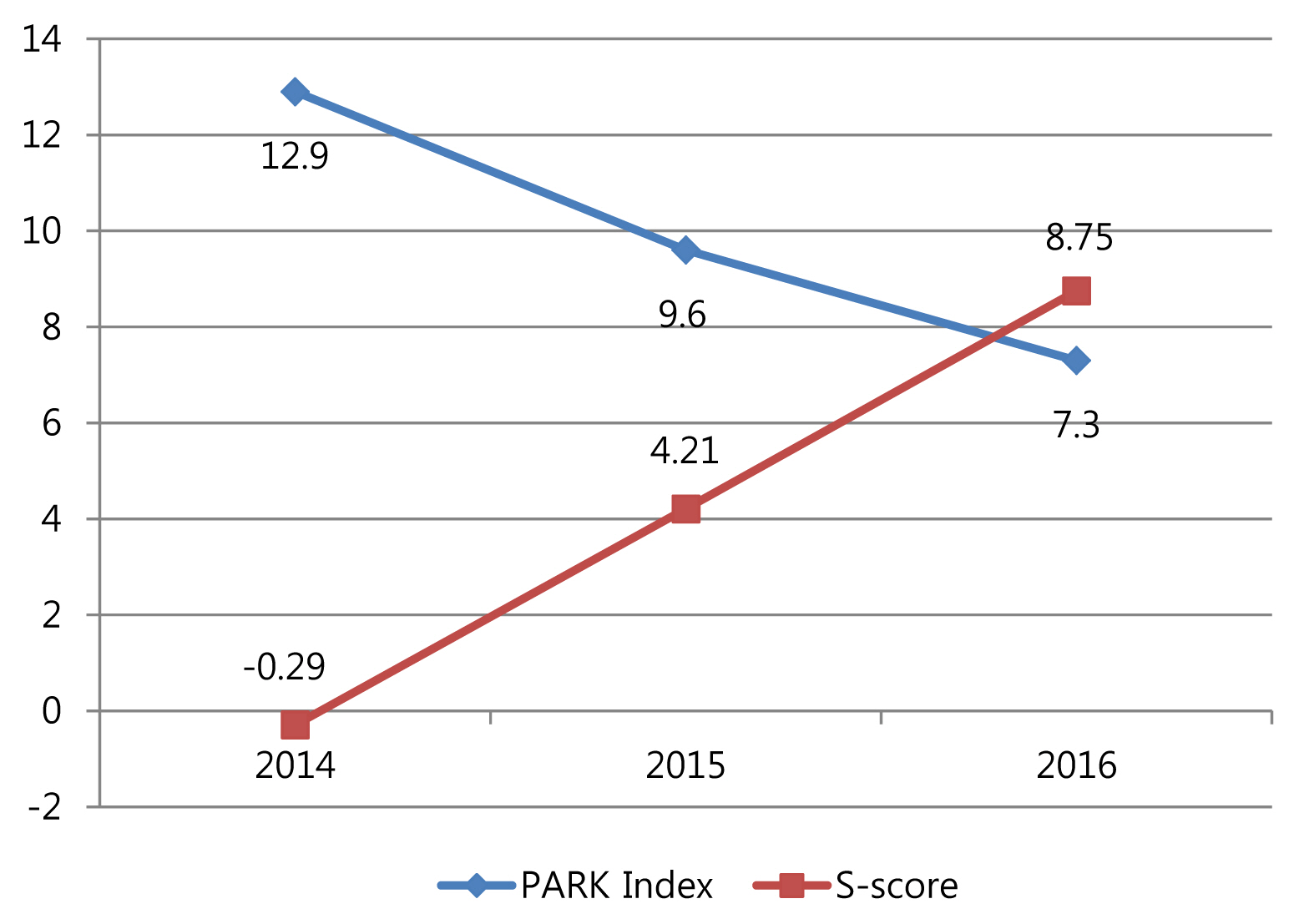PARK Index and S-score Can Be Good Quality Indicators for the Preventable Mortality in a Single Trauma Center
Article information
Abstract
Purpose
Preventable Trauma Death Rate (PTDR) using Trauma and Injury Severity Score (TRISS) has been most widely used as a quality indicator in South Korea. However, this method has a small number of deaths corresponding to the denominator. Therefore, it is difficult to check the change of quality improvement for annual mortality, and there is a disadvantage that variation is severe. Therefore, we attempted to improve the quality of the mortality evaluation by reducing the variation by applying the PARK Index (preventable major trauma death rate, PMTDR) which can increase the number of denominator significantly. And the Save score (S-score) was also examined as another quality indicator.
Methods
In the PARK Index, the denominator is number of all patients who have survival probability (Ps) larger than 0.25. Numerator is the number of deaths among these. The PARK Index includes only patients with ISS >15. The S-score is calculated in the same way as the W-score, but the S-score includes only patients with ISS >15, which is a difference from the W-score.
Results
PARK Index decreased annually and was 12.9 (37/287) in 2014, 9.6 (33/343) in 2015, and 7.3 (52/709) in 2016. S-score increased annually and was −0.29 in 2014, 4.21 in 2015, and 8.75 in 2016.
Conclusions
PARK Index and S-score improved annually. This shows that both quality indicators are improving year by year. PARK Index (PMTDR) has 9.5-fold increase in denominator overall compared to PTDR by TRISS. The S-score used only ISS >15 patients as a denominator. Therefore, there is an advantage that the numerical value change is larger than the W-score. In addition, S-score is not affected by the ratio of major trauma patients to minor trauma patients.
INTRODUCTION
According to the Statistics Korea data bank 2016, trauma is the 4th leading cause of death in Korea. Especially, amongst individuals aged 45 or less, who are the core of economic activity, trauma is the 1st leading cause of death, resulting in high socio-economical loss. Therefore, establishing a good trauma system in Korea is of utmost importance [1,2]. Based on these facts, Korea government has set a project of reducing preventable trauma death rate (PTDR) to 20% until 2020, which is a level compatible with developed country. Since 2012, Korea started to allocate designated trauma center, and currently at 2017, there are 16 regional dedicated trauma center in Korea [1].
Preventable trauma mortality rate, which is an important indicator for trauma center project, is a proportion of preventable deaths among mortality due to trauma, when a proper management was applied [3]. For this assessment, trauma and injury severity score (TRISS), International Classification of Disease-9 based injury severity score (ICISS), and professional panel study are widely used methods [4,5].
In Korea, professional panel study was the main method for the assessment of preventable trauma mortality [2,6–9]. Recently, Park et al. [10] proposed PARK Index (preventable major trauma death rate, PMTDR) as a new method of assessing preventable death in severely traumatized patient, which utilizes TRISS for calculation. Professional panel study use total number of mortality as a denominator, and for this reason, sample size is small, and it was difficult to compare annual mortality rate in a single trauma center. In contrast, PARK Index has an advantage of expanding the denominator 8.0 times higher. We authors tried to compare the annual PARK index in single trauma center, and to clarify whether the treatment result is improving. Also, we tried to clarify whether S-score utilizing only severely traumatized patients has an advantage over W-score. Author’s regional trauma center was established at 2015.
METHODS
Using Korean Trauma Data Bank (KTDB), total of 1864 patients who had injury severity score (ISS) 16 or more visited the Pusan National University Hospital from January 2014 to December 2016. Among them, 1,382 cases were used for study after the application of exclusion criteria. Exclusion criteria were: ISS less than 15, death on arrival cardiopulmonary resuscitation before arrival to the emergency department, trauma onset more than 24 hours, trauma mechanism other than blunt or penetrating, unidentifiable revised trauma score factor (Table 1).
Utilizing TRISS, the cases were divided into definitively preventable (DP), possible preventable (PP), non-preventable (NP) (Fig. 1).

Algolithm of magor trauma patients according to preventablility of death by trauma and injury severity score. DP: definitively preventable, Ps: survivla probablitiy, PP: possible preventable, NP: non-preventbable.
PTDR by TRISS
Traditional preventable mortality rate using TRISS uses ratio of preventable group (DP+PP) to total mortality as an indicator. The formula is as follows.
PARK Index (PMTDR)
PARK Index is a preventable mortality rate for severely traumatized patients, which uses rate of mortality case to preventable mortality case as an indicator. The formula is as follows.
S-score
S-score is similar to W-score, but S-score includes only severely traumatized case. Therefore, S-score is a difference between the real survived patients among 100 traumatized patients and expected survival cases based on mortality probability model. Formula for the calculation of S-score is as follows. For the study population, we compared annual PTDR, PARK index and S-score utilizing TRISS.
A means real survival cases among studied population, E means expected survival cases among studied population and T means number of severely traumatized patients (ISS >15).
RESULTS
Table 2 shows annual PTDR, PARK Index and S-score. PARK Index decreased annually: 12.9 (37/287) in 2014, 9.6 (33/343) in 2015, 7.3 (52/709) in 2016. Compared to the denominator of PTDR, the denominator of PARK Index was 7.2 times, 10.4 times, and 10.9 times higher in each year (40 vs. in 2014, 34 vs. 353 in 2015, 65 vs. 709 in 2016). S-score increased every year (−0.29 in 2014, 4.21 in 2015, 8.75 in 2016) PTDR was 92.5% 92.5% (37.40) in 2014, 97.1 (33/34) in 2015, 80% (52/65) in 2016. PARK Index and S-score increased every year in a single regional trauma center (Fig. 2).
DISCUSSION
The implication of preventable death rate is the ratio of deaths that were survivable cases when appropriate treatment was applied among all of death cases. And the following prerequisites are required to decide whether they are preventable [2]. 1) Injury should be trauma related, and the complications should be survivable, 2) treatment applied is standard or suboptimal, and 3) the confirmed error during treatment should be directly or indirectly related to the outcome.
Chiara et al. [4] suggested professional panel study, TRISS, and ICISS as a method of assessing preventable mortality rate. Professional panel study is a method widely used with long history [5,11]. However, during the initial working phase, it has a disadvantage of being subjective, which makes it not suitable for deciding the quality improvement in a single trauma center. Therefore, more objective assessment tool is required [12]. Method using ICISS presumes to use big data as a ground data, so it is not appropriate for a single trauma center. TRISS may be the most appropriate method for assessing quality improvement in single trauma center, but the denominator for the calculation is too small. In addition, it is difficult to use PTDR due to its large value and wide variation. This is because many patients are excluded because of the lack of transportation system of trauma patients in Korea. Therefore, TRISS also has a limitation of assessing single trauma center’s quality improvement and annual change [7–9].
Assessing preventable death rate in a trauma center is of utmost importance. And if it is easy to use, it would be better. And quality improvement activities also should be accompanied with this assessment. Kim et al. [13] reported that establishment of trauma system, systematic quality assessment, and quality improvement activities are all good methods for improving preventable death rate. And they also proposed that for these, verified and relevant quality assessment tool for trauma patient care should be established. In Korea, professional panel study, PTDR, and W-score has been used popularly to compare trauma centers. However, as previously mentioned, the number of trauma patients in a singer trauma center is low, which necessitates the effort for reducing error due to the low value of denominator. Jung et al. [8] and Kim et al. [9] reported preventable death rate in 2010 to be 35.2%, which is assessed by professional panel study. However, of those included in the study, over 70% of the hospital had a number of trauma mortality less than 30 cases, which was the limitation of that report.
In this study, the denominator of PARK Index was 9.5 times higher compared to the method using TRISS. By this way, PARK Index can improve the statistical stability as a quality indicator. W-score, another quality indicator, used total number of patients as a denominator, resulting in small difference in the result. In contrast, S-score used only severely traumatized patients as a denominator, which improved the limitation of W-score.
CONCLUSION
The denominator of PARK Index is 9.5 times higher compared to the PTDR calculated with TRISS. Therefore, PARK Index can reduce variation and increase stability, which can be used as a good indicator for quality assessment. S-score utilizes only severely traumatized patients a denominator, which has an advantage of not being affected by the ratio of severely/mildly traumatized patients. And also, S-score shows more expanded difference of the results compared to W-score.
In this study, PARK Index and S-score showed annual improvement as the trauma center’s establishment become. We propose PARK Index and S-score as a good indicator for annual compare method for trauma center. Further study is needed for more calrification.


